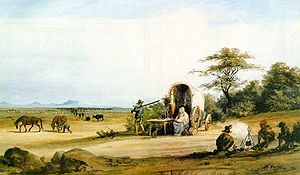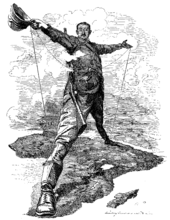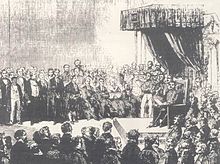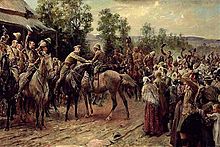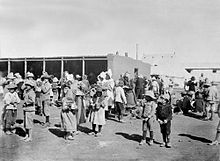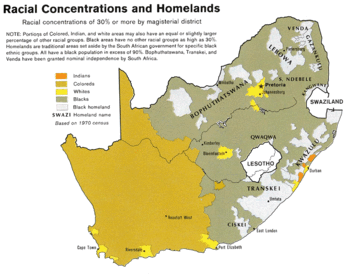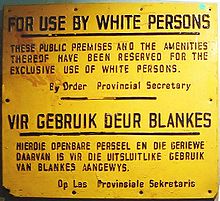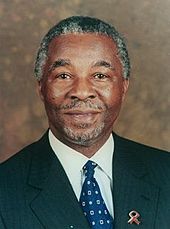
History of South Africa
Background to the schools Wikipedia
SOS Children have produced a selection of wikipedia articles for schools since 2005. With SOS Children you can choose to sponsor children in over a hundred countries
| Historical states in present-day South Africa |
|---|
 |
|
before 1600
|
|
1600–1700
|
|
1700–1800
|
|
1800–1850
|
|
1850–1875
|
|
1875–1900
|
|
1900–present
|
| more |
South African history has been dominated by the communication and conflict of several diverse ethnic groups. The aboriginal Khoikhoi people have lived in the region for millennia. Most of the population, however, trace their history to immigration since. Indigenous Africans in South Africa are descendants of immigrants from further north in Africa who first entered what are now the confines of the country roughly one thousand seven hundred years ago. White South Africans are descendants of later European settlers, mainly from the Netherlands and Britain. The Coloureds are descended at least in part from all of these groups, as well as from slaves from Madagascar, East Africa and the then East Indies, and there are many South Africans of Indian and Chinese origin, descendants of labourers who arrived in the nineteenth and early twentieth centuries. The history South Africa is taken here more broadly to cover the history not only of the current South African state but of other polities in the region, including those of the Khoisan, the several Bantu kingdoms in the region before colonisation, the rule of the Dutch in the Cape and the subsequent rule of the British there and in Natal, and the so-called Boer republics, including the Orange Free State and the South African Republic. South Africa was under an official system of racial segregation and white minority rule from 1948 known as Apartheid, until its first egalitarian elections in 1994, when the ruling African National Congress came to dominate the politics of the country.
Prehistoric South Africa
Paleolithic
Since Raymond Dart discovered the skull of the 2.5 million year old Taung Child in 1924, the first example of Australopithecus africanus ever found, South Africa has been considered one of the most important centres of early hominid evolution, alongside Kenya, Tanzania and Ethiopia. Following in Dart's footsteps Robert Broom discovered a new much more robust hominid in 1938 Paranthropus robustus at Kromdraai, and in 1947 uncovered several more examples of Australipitecus africanus in Sterkfontein. Many more species of early homind have come to light in recent decades. The oldest is Little Foot, a collection of footbones of an unknown hominid between 2.2 to 3.3 million years old, discovered at Sterkfontein by Ronald J. Clarke in 1994. An important recent find was that of 1.9 million year old Australopithecus sediba discovered by paleoanthropologist Lee R. Berger's nine-year-old son, Matthew in 2008.
South Africa was also occupied by early Homo Sapiens as shown by the discoveries at Klasies River Caves which revealed fossils and tools from 125,000-75,000 years ago in the middle stone-age. In 2002 in Blombos cave stones were discovered engraved with grid or cross-hatch patterns, dated to some 70,000 years ago. This has been interpreted as the earliest example of abstract art or symbolic art ever discovered.
Ancient and medieval history
Starting from around 500 BC, some San groups acquired livestock from further north. Gradually, hunting and gathering gave way to herding as the dominant economic activity as these San People tended to small herds of cattle and oxen. The arrival of livestock introduced concepts of personal wealth and property- ownership into San society. Community structures solidified and expanded, and chieftaincies developed. These pastoralist San People became known as Khoikhoi ('men of men'), as opposed to the still hunter-gatherer San People, whom the Colonialist Settlers referred to as Bushmen. At the point where the two groups became intermarried, mixed and hard to tell apart, the term Khoisan arose. Over time the Khoikhoi established themselves along the coast, while small groups of San continued to inhabit the interior.
Around 2,500 years ago Bantu peoples started migrating across sub-Saharan Africa from the Niger River Delta. The San People of Southern Africa and the Bantu-speakers didn't have any method of writing, so researchers know little of this period outside of archaeological artefacts
The Bantu-speakers had started to make their way south and eastwards in about 1000 BC, reaching the present-day KwaZulu-Natal Province by 500 CE. The Bantu-speakers had an advanced Iron Age culture, keeping domestic animals and also practising agriculture, farming sorghum and other crops. They lived in small settled villages. The Bantu-speakers arrived in South Africa in small waves rather than in one cohesive migration. Some groups, the ancestors of today's Nguni peoples (the Zulu, Xhosa, Swazi, and Ndebele), preferred to live near the coast. Others, now known as the Sotho–Tswana peoples ( Tswana, Pedi, and Basotho), settled in the Highveld, while today's Venda, Lemba, and Shangaan- Tsonga peoples made their homes in the north-eastern areas of South Africa
Bantu-speakers and Khoisan mixed, as evidenced by rock paintings showing the two different groups interacting. The type of contact remains unknown, although linguistic proof of integration survives, as several Southern Bantu languages (notably Xhosa and Zulu) incorporated many click consonants of earlier Khoisan languages. Archaeologists have found numerous Khoisan artefacts at the sites of Bantu settlements
In Mpumalanga, several stone circles have been found along with the stone arrangement that has been named Adam's Calendar.
From around 1200 AD a trade network began to emerge just to the North as is evidenced at such sites as Mapungubwe. Additionally, the idea of sacred leadership emerged – concept that transcends English terms such as “Kings” or “Queens”. Sacred leaders were elite members of the community, types of prophets, people with supernatural powers and the ability to predict the future.
Through interactions and trade with Muslim traders plying the Indian ocean as far south as present day Mozambique – the region emerged as a trade centre producing gold and ivory and trading for glass beads and porcelain from as far away as China.
Colonization
Following a brief period of Portuguese dominance in the area, South Africa went through two major periods of colonization. The first was that of the Dutch Cape Colony, established by the Dutch East India Company in 1652. This was followed by the British Cape Colony, first occupied from the Dutch in 1795, then returned at the Peace of Amiens (1802), and then re-occupied by the British in 1806, after the Battle of Blaauwberg.
European expeditions
Bartolomeu Dias was the first European to explore this region in 1488. Although the Portuguese basked in the nautical achievement of successfully navigating the cape, they showed little interest in colonisation. The area's fierce weather and rocky shoreline posed a threat to their ships, and many of their attempts to trade with the local Khoikhoi ended in conflict. The Portuguese found the Mozambican coast more attractive, with appealing bays to use as way stations, for prawning, and as links to gold ore in the interior.
The Portuguese had little competition in the region until the late 16th century, when the English and Dutch began to challenge the Portuguese along their trade routes. Stops at the continent's southern tip increased, and the cape became a regular stopover for scurvy-ridden crews. In 1647, a Dutch vessel, Haarlem, was wrecked in the present-day Table Bay at Cape Town. The marooned crew, the first Europeans to attempt settlement in the area, built a fort and stayed for a year until they were rescued.
Arrival of the Dutch
Shortly thereafter, the Dutch East India Company (in the Dutch of the day: Vereenigde Oostindische Compagnie, or VOC) decided to establish a permanent settlement. The VOC, one of the major European trading houses sailing the spice route to the East, had no intention of colonizing the area, instead wanting only to establish a secure base camp where passing ships could shelter, and where hungry sailors could stock up on fresh supplies of meat, fruit, and vegetables. To this end, a small VOC expedition under the command of Jan van Riebeeck reached Table Bay on 6 April 1652.
While the new settlement traded out of necessity with the neighbouring Khoikhoi, it was not a friendly relationship, and the company authorities made deliberate attempts to restrict contact. Partly as a consequence, VOC employees found themselves faced with a labour shortage. To remedy this, they released a small number of Dutch from their contracts and permitted them to establish farms, with which they would supply the VOC settlement from their harvests. This arrangement proved highly successful, producing abundant supplies of fruit, vegetables, wheat, and citrus fruits to prevent scurvy; they also later raised livestock. The small initial group of free burghers, as these farmers were known, steadily increased in number and began to expand their farms further north and east into the territory of the Khoikhoi.
The majority of burghers had Dutch ancestry and belonged to the Calvinist Reformed Church of the Netherlands, but there were also numerous Germans as well as some Scandinavians. In 1688 the Dutch and the Germans were joined by French Huguenots, also Calvinists, who were fleeing religious persecution in France under King Louis XIV.
In addition to establishing the free burgher system, van Riebeeck and the VOC also began to import large numbers of slaves, primarily from Madagascar and Indonesia. These slaves often married Dutch settlers, and their descendants became known as the Cape Coloureds and the Cape Malays. A significant number of the offspring from the White and slave unions were absorbed into the local proto-Afrikaans speaking White population. With this additional labour, the areas occupied by the VOC expanded further to the north and east, with inevitable clashes with the Khoikhoi. The newcomers drove the Khoikhoi from their traditional lands, decimated them with introduced diseases, and destroyed them with superior weapons when they fought back, which they did in a number of major wars and with guerrilla resistance movements that continued into the 19th century. Most survivors were left with no option but to work for the Europeans in an exploitative arrangement that differed little from slavery. Over time, the Khoisan, their European overseers, and the imported slaves mixed, with the offspring of these unions forming the basis for today's Coloured population.
The best-known Khoikhoi groups included the Griqua, who had originally lived on the western coast between St Helena Bay and the Cederberg Range. In the late 18th century, they managed to acquire guns and horses and began trekking north-east. En route, other groups of Khoisan, Coloureds, and even white adventurers joined them, and they rapidly gained a reputation as a formidable military force. Ultimately, the Griquas reached the Highveld around present-day Kimberley, where they carved out territory that came to be known as Griqualandalina.
Burgher expansion
As the burghers, too, continued to expand into the rugged hinterlands of the north and east, many began to take up a semi-nomadic pastoralist lifestyle, in some ways not far removed from that of the Khoikhoi they displaced. In addition to its herds, a family might have a wagon, a tent, a Bible, and a few guns. As they became more settled, they would build a mud-walled cottage, frequently located, by choice, days of travel from the nearest European settlement. These were the first of the Trekboers (Wandering Farmers, later shortened to Boers), completely independent of official controls, extraordinarily self-sufficient, and isolated. Their harsh lifestyle produced individualists who were well acquainted with the land. Like many pioneers with Christian backgrounds, the burghers attempted to live their lives – and to construct a theocracy – based on their particular Christian denominations ( Dutch Reformed Church) reading into ( eisegesis) characters and plot found in the Hebrew scriptures (as distinct from the Christian Gospels and Epistles).
British at the Cape
As the 18th century drew to a close, Dutch mercantile power began to fade and the British moved in to fill the vacuum. They seized the Cape in 1795 to prevent it from falling into French hands, then briefly relinquished it back to the Dutch (1803), before definitively conquering it in 1806. British sovereignty of the area was recognised at the Congress of Vienna in 1815.
At the tip of the continent the British found an established colony with 25,000 slaves, 20,000 white colonists, 15,000 Khoisan, and 1,000 freed black slaves. Power resided solely with a white élite in Cape Town, and differentiation on the basis of race was deeply entrenched. Outside Cape Town and the immediate hinterland, isolated black and white pastoralists populated the country.
Like the Dutch before them, the British initially had little interest in the Cape Colony, other than as a strategically located port. As one of their first tasks they tried to resolve a troublesome border dispute between the Boers and the Xhosa on the colony's eastern frontier. In 1820 the British authorities persuaded about 5,000 middle-class British immigrants (most of them "in trade") to leave Great Britain and settle on tracts of land between the feuding groups with the idea of providing a buffer zone. The plan was singularly unsuccessful. Within three years, almost half of these 1820 Settlers had retreated to the towns, notably Grahamstown and Port Elizabeth, to pursue the jobs they had held in Britain.
While doing nothing to resolve the border dispute, this influx of settlers solidified the British presence in the area, thus fracturing the relative unity of white South Africa. Where the Boers and their ideas had before gone largely unchallenged, white South Africa now had two distinct language groups and two distinct cultures. A pattern soon emerged whereby English-speakers became highly urbanised, and dominated politics, trade, finance, mining, and manufacturing, while the largely uneducated Boers were relegated to their farms.
The gap between the British settlers and the Boers further widened with the abolition of slavery in 1833, a move that the Boers generally regarded as against the God-given ordering of the races. Yet the British settlers' conservatism stopped any radical social reforms, and in 1841 the authorities passed a Masters and Servants Ordinance, which perpetuated white control. Meanwhile, numbers of British immigrants increased rapidly in Cape Town, in the area east of the Cape Colony (present-day Eastern Cape Province), in Natal. The later discovery of diamonds at Kimberley and the subsequent discovery of gold in parts of the Transvaal, mainly around present-day Gauteng led to a rapid increase in immigration of fortune seekers from all parts of the globe, including Africa itself.
Difaqane and destruction
The early 19th century saw a time of immense upheaval relating to the military expansion of the Zulu Kingdom. Sotho-speakers know this period as the difaqane (" forced migration"); while Zulu-speakers call it the mfecane ("crushing").
The full causes of the difaqane remain in dispute, although certain factors stand out. The rise of a unified Zulu kingdom had particular significance. In the early 19th century, Nguni tribes in KwaZulu-Natal began to shift from a loosely organised collection of kingdoms into a centralised, militaristic state. Shaka Zulu, son of the chief of the small Zulu clan, became the driving force behind this shift. At first something of an outcast, Shaka proved himself in battle and gradually succeeded in consolidating power in his own hands. He built large armies, breaking from clan tradition by placing the armies under the control of his own officers rather than of the hereditary chiefs. Shaka then set out on a massive programme of expansion, killing or enslaving those who resisted in the territories he conquered. His impis (warrior regiments) were rigorously disciplined: failure in battle meant death.
Peoples in the path of Shaka's armies moved out of his way, becoming in their turn aggressors against their neighbours. This wave of displacement spread throughout Southern Africa and beyond. It also accelerated the formation of several states, notably those of the Sotho (present-day Lesotho) and of the Swazi (now Swaziland).
In 1828 Shaka was killed by his half-brothers Dingaan and Umhlangana. The weaker and less-skilled Dingaan became king, relaxing military discipline while continuing the despotism. Dingaan also attempted to establish relations with the British traders on the Natal coast, but events had started to unfold that would see the demise of Zulu independence.
The Great Trek

Meanwhile, the Boers had started to grow increasingly dissatisfied with British rule in the Cape Colony. The British proclamation of the equality of the races particularly angered them, and they were also unhappy with the process of payment of compensation for slave-owners whose slaves had been freed. Beginning in 1835, several groups of Boers, together with large numbers of Khoikhoi and black servants, decided to trek off into the interior in search of greater independence. North and east of the Orange River (which formed the Cape Colony's frontier) these Boers or Voortrekkers (" Pioneers") found vast tracts of apparently uninhabited grazing lands. They had, it seemed, entered their promised land, with space enough for their cattle to graze and their culture of anti-urban independence to flourish. Little did they know that what they found – deserted pasture lands, disorganised bands of refugees, and tales of brutality – resulted from the difaqane, rather than representing the normal state of affairs.
With the exception of the more powerful Ndebele, the Voortrekkers encountered little resistance among the scattered peoples of the plains. The difaqane had dispersed them, and the remnants lacked horses and firearms. Their weakened condition also solidified the Boers' belief that European occupation meant the coming of civilisation to a savage land. However, the mountains where King Moshoeshoe I had started to forge the Basotho nation that would later become Lesotho and the wooded valleys of Zululand proved a more difficult proposition. Here the Boers met strong resistance, and their incursions set off a series of skirmishes, and treaties that would litter the next 50 years of increasing white domination.
British, Boers and Zulus
The Great Trek first halted at Thaba Nchu, near present-day Bloemfontein, where the trekkers established a republic. Following disagreements among their leadership, the various Voortrekker groups split apart. While some headed north, most crossed the Drakensberg into Natal with the idea of establishing a republic there.
Since the Zulus controlled this territory, the Voortrekker leader, accompanied by about 70 men of his Trek-Boer community, Piet Retief paid a visit to King Dingane kaSenzangakhona (Shaka's brother). Dingane promised them land in payment for a favour. The Batlokwa people, under chief Sekonyela had stolen cattle from him and he wanted it back. Retief went to them and retrieved the cattle. After receiving the specified cattle, Dingane invited Retief and his men into his kraal, where they were given all the land between the iZimvubu and Tugela rivers up to the Drakensberg. The treaty between the two men currently sits in a museum in The Netherlands. As a celebration, Dingane invited Retief and all his men to come and drink uTshwala (Traditional Zulu Beer) in his kraal, but the Boers had to leave all their weapons outside. Also included in the offer were guns and money. While drinking and being entertained by Zulu dancers, Dingane cried out "Bulalani abathakathi" (Kill the wizards"; also sometimes reported as "Bambani abathakathi", "Seize the wizards"). Dingane's men, having taken Retief's men by surprise, dragged the men to a hill Hloma Mabuto (or perhaps kwaMatiwane) where, one by one, they were all killed, leaving Retief for last so that he could watch.
After the massacre, the impis went back to the encampment where Retief and his fellow farmers had left their wives, children and livestock. Taken by surprise, the women, children and remaining farmers (numbering about 500) were also killed at the site called "Weenen", but not without retribution, they themselves managed to stop the initial onslaught and managed to get away, without many of their guns and animals. A missionary, Rev. Owen, had seen all of this take place and approached Dingane in order to give the dead an appropriate burial. While the reverend and a helper of his were burying the dead and reading them their last rights, they happened to come across Retief's rucksack, still containing the treaty and a few personal belongings.
At the Battle of Itala, a Boer army's attempt at revenge failed miserably. The culmination came on 16 December 1838, at the Ncome River in Natal. The Boers established a defensive enclosure or laager before the Zulu attack. Though only three Boers suffered injuries, they killed about three thousand Zulu warriors using three cannons and an elephant gun (along with other weapons). Before the battle, on 9 December 1838, the Boers made a vow to God that if He protected them and defeated their enemy, they will build a church in His name and they and their offspring will remember the day and the date. In remembrance of this vow, 16 December became a South African public holiday in the 1920s. So much bloodshed reportedly caused the Ncome's waters to run red, thus the clash is historically known as the Battle of Blood River.
The Voortrekkers, victorious despite their numbers, saw their victory as an affirmation of divine approval. Yet their hopes for establishing a Natal republic remained short lived. The British annexed the area in 1843, and founded their new Natal colony at present-day Durban. Most of the Boers, feeling increasingly squeezed between the British on one side and the native African populations on the other, headed north.
The British set about establishing large sugar plantations in Natal, but found few inhabitants of the neighbouring Zulu areas willing to provide labour. The British confronted stiff resistance to their encroachments from the Zulus, a nation with well-established traditions of waging war, who inflicted one of the most humiliating defeats on the British army at the Battle of Isandlwana in 1879, where over 1400 British soldiers were killed. During the ongoing Anglo-Zulu Wars, the British eventually established their control over what was then named Zululand, and is today known as KwaZulu-Natal Province.
The British turned to India to resolve their labour shortage, as Zulu men refused to adopt the servile position of labourers and in 1860 the SS Truro arrived in Durban harbour with over 300 people on board. Over the next 50 years, 150,000 more indentured Indians arrived, as well as numerous free "passenger Indians", building the base for what would become the largest Indian community outside India. As early as 1893, when Mahatma Gandhi arrived in Durban, Indians outnumbered whites in Natal. (See Asians in South Africa.)
Growth of independent South Africa
The Boer republics
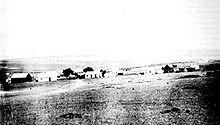
The Boers meanwhile persevered with their search for land and freedom, ultimately establishing themselves in various Boer Republics, e.g. the Transvaal or South African Republic and the Orange Free State. For a while it seemed that these republics would develop into stable states, despite having thinly spread populations of fiercely independent Boers, no industry, and minimal agriculture. The discovery of diamonds near Kimberley turned the Boers' world on its head (1869). The first diamonds came from land belonging to the Griqua, but to which both the Transvaal and Orange Free State laid claim. Britain quickly stepped in and resolved the issue by annexing the area for itself.
The discovery of the Kimberley diamond-mines unleashed a flood of European and black labourers into the area. Towns sprang up in which the inhabitants ignored the "proper" separation of whites and blacks, and the Boers expressed anger that their impoverished republics had missed out on the economic benefits of this Mineral Revolution.
The Cape Colony
Starting from the mid-1800s, the largest state in southern Africa, the Cape of Good Hope, began a slow move towards greater independence from Britain. In 1854, it was granted its first locally elected legislature, the Cape Parliament. In 1872, after a long political struggle, it attained responsible government with a locally accountable executive and Prime Minister. The Cape nonetheless remained nominally part of the British Empire, even though it was self-governing in practice. The Cape Colony was unusual in southern Africa in that its laws prohibited any discrimination on the basis of race and, unlike the Boer republics, elections were held according to the non-racial Cape Qualified Franchise system, whereby suffrage qualifications applied universally, regardless of race.
Initially, a period of strong economic growth and social development ensued. However, an ill-informed British attempt to force the states of southern Africa into a British federation led to inter-ethnic tensions and the First Boer War. Meanwhile, the discovery of diamonds around Kimberley and gold in the Transvaal led to a later return to instability, particularly because they fueled the rise to power of the ambitious colonialist Cecil Rhodes. As Cape Prime Minister, Rhodes curtailed the multi-racial franchise, and his expansionist policies set the stage for the Second Boer War.
Anglo-Boer Wars
First Anglo-Boer War
The Transvaal Boer republic was forcefully annexed by Britain in 1877, during its attempt to federate the states of southern Africa under British rule. Long-standing Boer resentment turned into full-blown rebellion in the Transvaal and the first Anglo-Boer War, known to Afrikaners as the "War of Independence", broke out in 1880. The conflict ended almost as soon as it began with a crushing Boer victory at Battle of Majuba Hill (27 February 1881). The republic regained its independence as the Zuid-Afrikaansche Republiek (" South African Republic"), or ZAR. Paul Kruger, one of the leaders of the uprising, became President of the ZAR in 1883. Meanwhile, the British, who viewed their defeat at Majuba as an aberration, forged ahead with their desire to federate the Southern African colonies and republics. They saw this as the best way to come to terms with the fact of a white Afrikaner majority, as well as to promote their larger strategic interests in the area.
Inter-war period
In 1879 Zululand came under British control. Then in 1886 an Australian prospector discovered gold in the Witwatersrand, accelerating the federation process and dealing the Boers yet another blow. Johannesburg's population exploded to about 100,000 by the mid-1890s, and the ZAR suddenly found itself hosting thousands of uitlanders, both black and white, with the Boers squeezed to the sidelines. The influx of Black labour in particular worried the Boers, as the shortage of jobs meant that they would suffer further economic hardships.
The enormous wealth of the mines, largely controlled by European " Randlords" soon became irresistible for the British. In 1895, a group of renegades led by Captain Leander Starr Jameson entered the ZAR with the intention of sparking an uprising on the Witwatersrand and installing a British administration. This incursion became known as the Jameson Raid. The scheme ended in fiasco, but it seemed obvious to Kruger that it had at least the tacit approval of the Cape Colony government, and that his republic faced danger. He reacted by forming an alliance with Orange Free State.
Second Anglo-Boer War
The situation peaked in 1899 when the British demanded voting rights for the 60,000 foreign whites on the Witwatersrand. Until that point, Kruger's government had excluded all foreigners from the franchise. Kruger rejected the British demand and called for the withdrawal of British troops from the ZAR's borders. When the British refused, Kruger declared war. This Second Anglo-Boer War lasted longer than the first, and the British preparedness surpassed that of Majuba Hill. By June 1900, Pretoria, the last of the major Boer towns, had surrendered. Yet resistance by Boer bittereinders continued for two more years with guerrilla-style battles, which the British met in turn with scorched earth tactics. By 1902 26,000 Boer women and children had died of disease and neglect in British concentration camps. On 31 May 1902 a superficial peace came with the signing of the Treaty of Vereeniging. Under its terms, the Boer republics acknowledged British sovereignty, while the British in turn committed themselves to reconstruction of the areas under their control.
Union of South Africa

During the immediate post-war years the British focused their attention on rebuilding the country, in particular the mining industry. By 1907 the mines of the Witwatersrand produced almost one-third of the world's annual gold production. But the peace brought by the treaty remained fragile and challenged on all sides. The Afrikaners found themselves in the ignominious position of poor farmers in a country where big mining ventures and foreign capital rendered them irrelevant. Britain's unsuccessful attempts to Anglicise them, and to impose English as the official language in schools and the workplace particularly incensed them. Partly as a backlash to this, the Boers came to see Afrikaans as the volkstaal ("people's language") and as a symbol of Afrikaner nationhood. Several nationalist organisations sprang up.
The system left Blacks and Coloureds completely marginalised. The authorities imposed harsh taxes and reduced wages, while the British caretaker administrator encouraged the immigration of thousands of Chinese to undercut any resistance. Resentment exploded in the Bambatha Rebellion of 1906, in which 4,000 Zulus lost their lives after protesting against onerous tax legislation.
The British meanwhile moved ahead with their plans for union. After several years of negotiations, the South Africa Act 1909 brought the colonies and republics – Cape Colony, Natal, Transvaal, and Orange Free State – together as the Union of South Africa. Under the provisions of the act, the Union remained British territory, but with home-rule for Afrikaners. The British High Commission territories of Basutoland (now Lesotho), Bechuanaland (now Botswana), Swaziland and Rhodesia now Zimbabwe) and continued under direct rule from Britain.
English and Dutch became the official languages. Afrikaans did not gain recognition as an official language until 1925. Despite a major campaign by Blacks and Coloureds, the voter franchise remained as in the pre-Union republics and colonies, and only whites could gain election to parliament.
Most significantly, the new Union of South Africa gained international respect with British Dominion status putting it on par with three other important British dominions and allies: Canada, Australia, and New Zealand.
The Natives' Land Act of 1913 was the first major piece of segregation legislation passed by the Union Parliament, and remained a cornerstone of Apartheid until the 1990s when it was replaced by the current policy of land restitution. Under the act, blacks were relatively restricted from the legal ownership of land, at that stage to 7% of the country. This percentage later increased to 13%, at about 158, 734 km2 a 1/6 bigger than Greece, resulting in an estimated population density of 30/km2, the same as modern USA. The Act created a system of land tenure that deprived the majority of South Africa's inhabitants of the right to own land outside of reserves which had major socio-economic repercussions, because the owners did not develop and leverage the land into a successful commercial resource.
Segregationist legislation also included the Franchise and Ballot Act (1892), which limited the black vote by finance and education, the Natal Legislative Assembly Bill (1894), which deprived Indians of the right to vote; the General Pass Regulations Bill (1905), which denied blacks the vote altogether, limited them to fixed areas and inaugurated the infamous Pass System; the Asiatic Registration Act (1906) requiring all Indians to register and carry passes; the South Africa Act (1910) that enfranchised whites, giving them complete political control over all other race groups; the above-mentioned Native Land Act (1913) which prevented all blacks, except those in the Cape, from buying land outside 'reserves'. The reserves were the "original homes" of the black tribes of South Africa. The reserves later became known as bantustans of which the failed objective was to make self-governing, quasi-independent ethnically homogeneous states. At this time the state effectively reserved 87% of the land which whites exclusively could purchase; the Natives in Urban Areas Bill (1918) designed to move blacks living in "white" South Africa into specific 'locations' as a precautionary security measure; the Urban Areas Act (1923) which introduced residential segregation in South Africa and provided cheap unskilled labour for the white mining and farming industry; the Colour Bar Act (1926), preventing blacks from practising skilled trades; the Native Administration Act (1927) that made the British Crown, rather than paramount chiefs, the supreme head over all African affairs; the Native Land and Trust Act (1936) that complemented the 1913 Native Land Act and, in the same year, the Representation of Natives Act, which removed blacks from the Cape voters' roll. The final 'apartheid' legislation passed by the South African parliament before the beginning of the 'Apartheid' era was the Asiatic Land Tenure Bill (1946), which banned any further land sales to Indians.
Participation in World Wars

At the outbreak of World War I, South Africa joined Great Britain and the Allies against the German Empire. Both Prime Minister Louis Botha and Defence Minister Jan Smuts, were former Second Boer War generals who had fought against the British then, but they now became active and respected members of the Imperial War Cabinet. Elements of the South African army refused to fight against the Germans and along with other opponents of the government they rose in an open revolt known as the Maritz Rebellion. The government declared martial law on 14 October 1914, and forces loyal to the government under the command of General Louis Botha and Jan Smuts proceeded to destroy the rebellion. The leading Boer activists were convicted and given terms of imprisonment of six and seven years and heavy fines.
Nearly a quarter million South Africans served in South African military units in supporting the Allies during World War I. This included 43,000 in German South-West Africa and 30,000 on the Western Front. An estimated 3,000 South Africans also joined the Royal Flying Corps. The total South African casualties during the war was about 18,600. South Africa assisted the Allied war effort by capturing the two German colonies of German West Africa and German East Africa, as well as participating in battles in Western Europe and the Middle East.
During World War II, South Africa's ports and harbours, such as at Cape Town, Durban, and Simon's Town, were important strategic assets to the British Royal Navy. About 334,000 South Africans volunteered for full-time military service in support of the Allies abroad. Nearly 9,000 were killed in action and many others were captured by the Axis and held as prisoners of war. Prime Minister Jan Smuts was the only important non-British general whose advice was constantly sought by Britain's war-time Prime Minister Winston Churchill. Smuts was invited to the Imperial War Cabinet in 1939 as the most senior South African in favour of war. On 28 May 1941, Smuts was appointed a Field Marshal of the British Army, becoming the first South African to hold that rank. When the war ended, Smuts represented South Africa in San Francisco at the drafting of the United Nations Charter in May 1945. Just as he had done in 1919, Smuts urged the delegates to create a powerful international body to preserve peace; he was determined that, unlike the League of Nations, the UN would have teeth. Smuts also signed the Paris Peace Treaty, resolving the peace in Europe, thus becoming the only signatory of both the treaty ending the First World War, and that which ended the Second.
In October, 1945, following the end of World War II, both the Labour party, and the Dominion Party withdrew from the coalition government, leaving Jan Smuts and the United Party (South Africa) in complete control. Smuts later paid a heavy political price for his closeness to the British establishment, which had made him unpopular among the majority of conservative nationalist Afrikaners, leading ultimately to his political downfall in the 1948 general election. Most English-speaking whites and a minority of liberal Afrikaners in South Africa remained loyal to him.
General elections and the slow evolution of democracy
From 1910 until 1948 the franchise to vote was gradually evolved from allowing "qualified" male population (with non-whites enfranchised in the Cape Province and Natal) to gradual disenfranchisement of all South African Blacks, who were moved to a separate voters' roll in 1936. All whites over the age of 21, including women were given the right to vote in 1930. After the ascent of the National Party to power in 1948, the Black voters' roll was abolished. Cape Coloureds were moved to a separate voters' role, and subsequently disenfranchised altogether in 1970. Only whites were permitted to vote in general elections from 1958 until 1994 when the vote was granted to all South Africans over age 18. The 1994 general election was the first post-apartheid vote based on universal suffrage.
There have been three referendums in South Africa: 1960 referendum on becoming a republic; 1983 referendum on implementing the tricameral parliament; and 1992 referendum on becoming a multiracial democracy all of which were held during the era of National Party control.
Apartheid era
| Apartheid in South Africa |
|---|
| Events and projects |
|
| Organisations |
|
| People |
|
| Places |
|
| Related topics |
|
|
Afrikaner nationalism
General Louis Botha headed the first government of the new Union, with General Jan Smuts as his deputy. Their South African National Party, later known as the South African Party or SAP, followed a generally pro-British, white-unity line. The more radical Boers split away under the leadership of General Barry Hertzog, forming the National Party (NP) in 1914. The NP championed Afrikaner interests, advocating separate development for the two white groups and independence from Britain.
The new Union had no place for Blacks, despite their constituting over 75 percent of the population. The Act of Union denied them voting-rights in the Transvaal and Orange Free State areas, and in Cape Province Blacks gained the vote only if they met a property-ownership qualification. Blacks saw the failure to grant the franchise, coming on the heels of British wartime propaganda promoting freedom from "Boer slavery", as a blatant betrayal. Before long the Union passed a barrage of oppressive legislation, making it illegal for black workers to strike, reserving skilled jobs for whites, barring blacks from military service, and instituting restrictive pass laws. In 1913 parliament enacted the Natives' Land Act, setting aside eight percent of South Africa's land for black occupancy. Whites, who made up only 20 percent of the population, held 90 percent of the land. Black Africans could not buy or rent land or even work as share-croppers outside their designated area. The authorities evicted thousands of squatters from farms and forced them into increasingly overcrowded and impoverished reserves, or into the cities. Those who remained sank to the status of landless labourers.
Black and Coloured opposition began to coalesce, and leading figures such as John Jabavu, Walter Rubusana and Abdullah Abdurahman laid the foundations for new non-tribal black political groups. Most significantly, a Columbia University-educated attorney, Pixley ka Isaka Seme, called together representatives of the various African tribes to form a unified, national organisation to represent the interests of blacks, and to ensure that they had an effective voice in the new Union. Thus there originated the South African Native National Congress, known from 1923 as the African National Congress (ANC). Parallel to this, Mahatma Gandhi worked with the Indian populations of Natal and the Transvaal to fight against the ever-increasing encroachment on their rights.
The international recession which followed World War I put pressures on mine-owners, and they sought to reduce costs by recruiting lower-paid, black, semi-skilled workers. White mine-workers saw this as a threat and in 1922 rose in the armed Rand Rebellion, supported by the new Communist Party of South Africa under the slogan "Workers of the World, unite and fight for a white South Africa." Smuts suppressed the rising violently, but the failure led to a convergence of views between Afrikaner nationalists and white English-speaking trade-unionists. The Communists saw the failure as having resulted from a lack of mobilisation by black workers, and re-oriented their recruitment.
In 1924 the NP, under Hertzog, came to power in a coalition government with the Labour Party, and Afrikaner nationalism gained greater hold. Afrikaans, previously regarded only as a low-class dialect of Dutch, replaced Dutch as an official language of the Union, and the so-called swart gevaar (black peril) became the dominant issue of the 1929 election. In the mid-1930s, Hertzog joined the NP with the more moderate SAP of Jan Smuts to form the United Party; this coalition fell apart at the start World War II when Smuts took the reins and, amid much controversy, led South Africa into war on the side of the Allies. However, any hopes of turning the tide of Afrikaner nationalism faded when Daniel François Malan led a radical break-away movement, the Purified National Party, to the central position in Afrikaner political life. The Afrikaner Broederbond, a secret Afrikaner brotherhood formed in 1918 to protect Afrikaner culture, soon became an extraordinarily influential force behind both the NP and other organisations designed to promote the volk ("people", the Afrikaners).
Due to the booming wartime economy, black labour became increasingly important to the mining and manufacturing industries, and the black urban population nearly doubled. Enormous squatter camps grew up on the outskirts of Johannesburg and (though to a lesser extent) outside the other major cities. Despite the appalling conditions in the townships, not only blacks knew poverty: wartime surveys found that 40 percent of white schoolchildren suffered from malnutrition.
Legalised discrimination
From 1948 successive National Party administrations formalised and extended the existing system of racial discrimination and denial of human rights into the legal system of apartheid, which lasted until 1991. Although many important events occurred during this period, apartheid remained the central system around which most of the historical issues of this period revolved, including violent conflict and the militarisation of South African society.
In the mid-1980s, Joint Management Centres (JMCs) operating in at least 34 State-designated "high-risk" areas became the key element in a National Security Management System. The police and military who controlled the JMCs were endowed with influence in decision-making at every level, from the Cabinet down to local government. At the same time, police and army death squads conducted covert, State-sponsored assassinations of dissidents and activists. By mid-1987 the Human Rights Commission knew of at least 140 political assassinations in the country, while about 200 people died at the hands of South African agents in neighbouring states. The exact numbers of all the victims may never be known. Strict censorship disallowed journalists from reporting, filming or photographing such incidents, while the government ran its own covert disinformation programme that provided distorted accounts of the extrajudicial killings. At the same time, State-sponsored vigilante groups carried out violent attacks on communities and community leaders associated with resistance to apartheid. The attacks were then falsely attributed by the government to "black-on-black" or factional violence within the communities. The Truth and Reconciliation Commission (TRC) would later establish that a covert, informal network of former or still serving army and police operatives, frequently acting in conjunction with extreme right-wing elements, was involved in actions that could be construed as fomenting violence and which resulted in gross human rights violations, including random and targeted killings.
Extra-parliamentary activities
The early 1940s saw the pro-Nazi Ossewa Brandwag (OB) movement become half-a-million strong, including future prime minister John Vorster and future head of police intelligence Hendrik van den Bergh. The anti-semitic Boerenasie (Boer Nation) and other similar groups soon joined them. When the war ended, the OB was one of the anti-parliamentary groups absorbed into the National Party. An era of Nazi-type legislation followed, including the banning of anti-apartheid terror movements such as the Communist Party of South Africa and the African National Congress.
Dismantling apartheid
With increasing local and international opposition to apartheid in the 1980s, including an armed struggle, widespread civil unrest, economic and cultural sanctions by the international community, and pressure from the anti-apartheid movement around the world, State President FW de Klerk announced the unbanning of the African National Congress and Pan Africanist Congress as well as the release of Nelson Mandela on 2 February 1990, which signalled the beginning of a transition to democracy. In the referendum held on 17 March 1992 a white electorate voted 68% in favour of dismantling apartheid through negotiations.
After years of negotiations under the auspices of the Convention for a Democratic South Africa (CODESA), a draft constitution appeared on 26 July 1993, containing concessions towards all sides: a federal system of regional legislatures, equal voting-rights regardless of race, and a bicameral legislature. The neo-Nazi Afrikaner Weerstandsbeweging (AWB) – "Afrikaner Resistance Movement" – attempted unsuccessfully to derail the negotiations through various acts of public violence and intimidation. From 26 to 29 April 1994 the South African population voted in the first universal suffrage general elections. The African National Congress won election to govern for the very first time, leaving the National Party and the Inkatha Freedom Party behind it and parties such as the Democratic Party and Pan Africanist Congress took up their seats as part of the parliamentary opposition in the first genuine multiracial parliament. Nelson Mandela was elected as President on 9 May 1994 and formed – according to the interim constitution of 1993 – a government of national unity, consisting of the ANC, the NP and the Inkatha. On 10 May Mandela was inaugurated as South Africa's new President in Pretoria and Thabo Mbeki and FW De Klerk as his vice-presidents.
After considerable debate, and following submissions from advocacy groups, individuals and ordinary citizens, the Parliament enacted a new Constitution and Bill of Rights in 1996.
In early 2002 a planned military coup by a white supremacist movement known as the Boeremag (Boer Force) was foiled by the South African police. Two dozen conspirators including senior South African Army officers were arrested and the extremist organisation dismantled. The effectiveness of the police in foiling the planned coup strengthened public perceptions that the democratic order was irreversible.
Truth and Reconciliation Commission
After the enactment of the constitution focus turned to the Truth and Reconciliation Commission, established in 1995 under the dictum of Archbishop Desmond Tutu to expose crimes committed during the apartheid era. The commission heard many stories of brutality and injustice from all sides and offered some catharsis to people and communities shattered by their past experiences. The Commission operated by allowing victims to tell their stories and by allowing perpetrators to confess their guilt; with amnesty on offer to those who made a full confession. Those who chose not to appear before the commission would face criminal prosecution if the authorities could prove their guilt. But while some soldiers, police, and ordinary citizens confessed their crimes, few of those who had given the orders or commanded the police presented themselves. State President P.W. Botha himself, notably, refused to appear before the Commission. It proved difficult to gather evidence against these alleged higher-level criminals including Nelson Mandela himself.
In 1961, Mandela became the leader of the ANC's armed wing, Umkhonto we Sizwe (translated as Spear of the Nation, also abbreviated as MK), which he co-founded. He coordinated a sabotage campaign against military and government targets, and made plans for a possible guerrilla war if sabotage failed to end apartheid. A few decades later, MK did wage a guerrilla war against the regime, especially during the 1980s, in which many civilians were killed. Mandela also raised funds for MK abroad, and arranged for paramilitary training, visiting various African governments.
Mandela explains the move to embark on armed struggle as a last resort, when increasing repression and violence from the state convinced him that many years of non-violent protest against apartheid had achieved nothing and could not succeed.[6]
Mandela later admitted that the ANC, in its struggle against apartheid, also violated human rights, and has sharply criticised attempts by parts of his party to remove statements supporting this fact from the reports of the Truth and Reconciliation Commission. .



